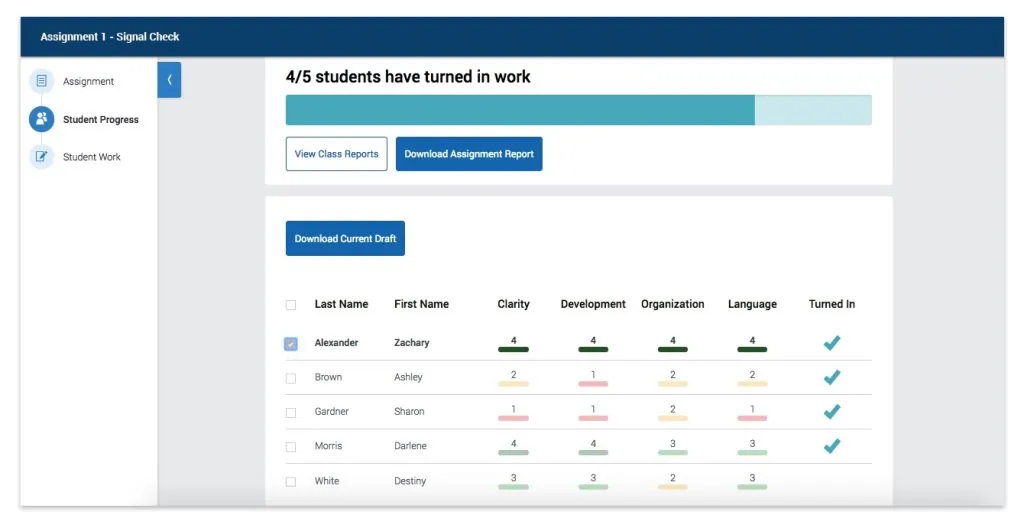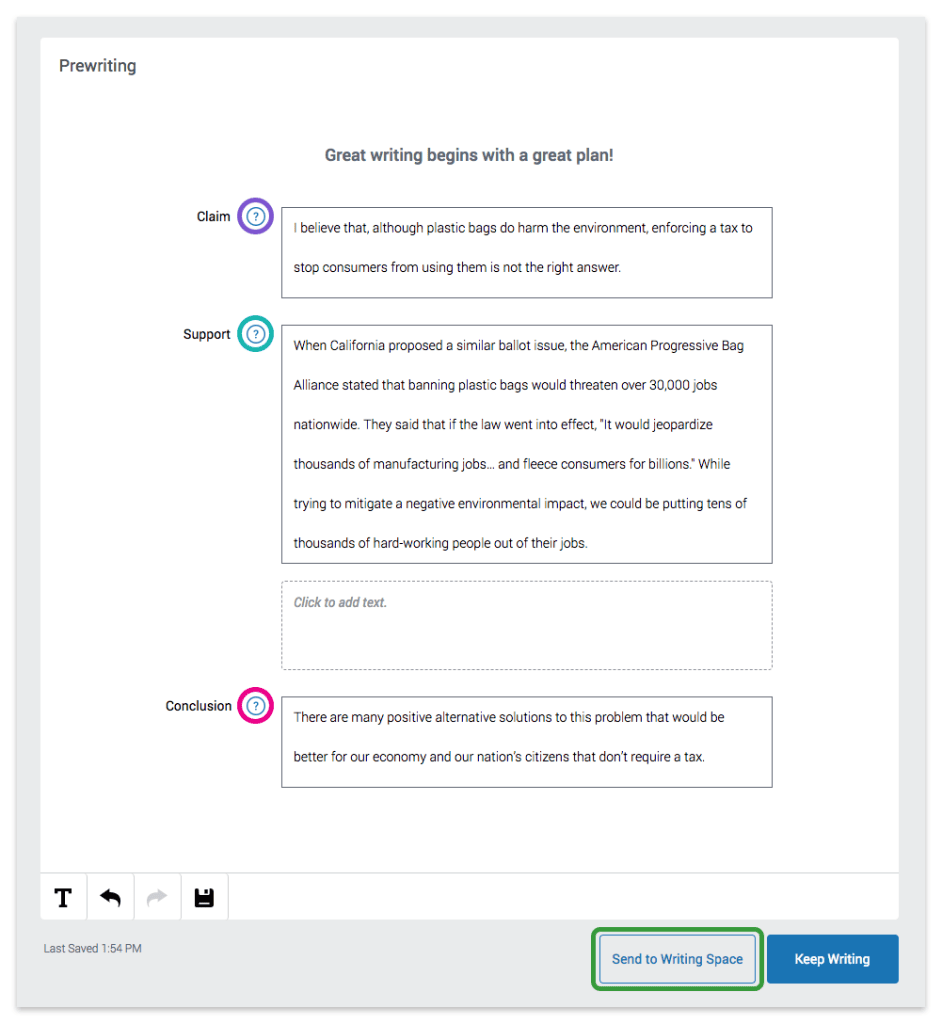Turnitin is an educational software designed to detect plagiarism in students’ work. It operates by comparing submitted papers against a vast range of databases to identify potentially unoriginal content, utilizing a proprietary algorithm for this comparison.
Its databases include not only its archives but also many academic proprietary databases due to licensing agreements. With the astronomical rise of AI, the question is: does Turnitin detect ChatGPT written content?
What is Turnitin?
Turnitin is a web-based service that finds similar portions in submitted papers and other sources such as websites, scholarly journal articles, and other student papers. Following the analysis, it generates an Originality Report highlighting the matching text.
Turnitin is powered by a cutting-edge technology that is frequently used in the educational sector. It operates by cross-referencing written content with a huge database of scholarly work, web-based resources, and previously submitted papers to maintain academic integrity.
With an accuracy of up to 98 percent, this software detects similarities and suspected plagiarism situations. Turnitin is more than simply a text-matching tool; it provides extensive writing aids and source verification.
Its use ranges from originality assessment to AI-generated text detection. Notably, Turnitin has grown to detect writings helped by or entirely generated by AI, such as ChatGPT from OpenAI’s GPT family of big language models.
Such improvements are critical to maintaining the legitimacy of diverse written exchanges in academia and other disciplines that require severe content assessment. However, because the foundation of its function is internet-based comparison, its efficiency suffers when dealing with offline sources.

David Adamson, a guy with a background in both academia and artificial intelligence, is a major figure leading Turnitin’s AI writing detection.
David Adamson is a former high school teacher who knows the nuances and complexities of academic writing. He is not just another tech-savvy developer looking to cash in on the newest AI wave. This dual experience qualifies him to spearhead Turnitin’s journey into AI writing detection.
Adamson has authored numerous papers and led numerous Turnitin projects to harness AI to improve academic integrity and writing quality. His work has gained him acclaim in both the educational and technological spheres.
How does Turnitin work?
As previously stated, Turnitin employs a sophisticated algorithm that compares work to a huge database of academic papers, websites, books, and other online resources. When the scan is finished, it discovers matching word strings and generates a similarity report.

This report emphasizes any text in a student’s work that corresponds closely to sources in its database.
Turnitin, on the other hand, does more than compare texts. It has also evolved to recognize AI-assisted writing by identifying patterns common to AI outputs such as ChatGPT. Unusual language use or tone and discrepancies in writing styles can trigger red flags for AI use.
This intelligent technology is constantly refined and improved to keep up with quickly evolving AI capabilities.
Can Turnitin Detect Chat GPT?
Turnitin has raised the bar in AI-generated text detection. Turnitin’s sophisticated technology now accurately detects content generated by tools like ChatGPT.
This innovation assists instructors in avoiding AI-assisted writing, guaranteeing that original student submissions are prioritized in academic grading.
The accuracy percentage is an astounding 98%. This high level of precision comforts educational institutions concerned about sustaining academic standards. Detecting AI-generated information keeps academia pure and free of the impact of automated technology, allowing students to rely on their own abilities rather than AI assistance.
Not only does it detect situations when students may have used ChatGPT or comparable advanced AI models, it also detects all types of electronically assisted plagiarism.
The ability of Turnitin to detect ChatGPT is a big step toward ensuring real learning and maintaining academic integrity in our schools and colleges.
How Does Turnitin Detect ChatGPT?
Turnitin leverages advanced AI detection technology to spot signs of language models like ChatGPT in submitted papers, but how does it really discern between human and machine-generated text?
One compelling case study involves Turnitin’s ability to identify AI-generated explanations of etymology, specifically the word “thing.”
The “thing” test
Turnitin’s AI detector distinguishes artificial intelligence’s take on the origins of the word “thing” from human-written scholarly articles. The platform checks for certain patterns and nuances typically associated with machine-generated content.
In a blind test involving 20 etymology scholars, Turnitin correctly identified ChatGPT-generated content 95% of the time. This is a testament to Turnitin’s precision in flagging AI-generated academic work.
The findings of this case study reflect Turnitin’s expertise in preserving academic research integrity, ensuring that the information can withstand the most rigorous scholarly scrutiny.
The Arthur Conan Doyle Experiment: Distinguishing Between Human and AI Edits
A case study centered around the works of Arthur Conan Doyle demonstrated Turnitin’s capabilities to detect GPT-generated edits intermingled with human writing.
Editing classic texts like “Sherlock Holmes” stories offers a layered challenge. Turnitin underwent testing to see if it could spot textual changes made by ChatGPT apart from Doyle’s original text. The AI detector analyzed syntax, diction, and phrasing nuances to distinguish AI and human contributions.
The Arthur Conan Doyle Experiment concluded with Turnitin accurately separating human and AI edits in 88 out of 100 test cases, scoring an impressive accuracy rate of 88%.
Turnitin’s AI detector’s performance in these case studies has critical and far-reaching ramifications for academic integrity.
Turnitin’s ability to reliably detect GPT-generated content and modifications brings a new layer of protection and integrity to the academic world. Is it possible for Turnitin to detect AI-generated content? The data strongly suggests that the answer to this question is yes.
Turnitin’s technology is being integrated with existing academic databases, Learning Management Systems (LMS), and even other plagiarism detection technologies via APIs and compatibility layers. This assures that the technology may be widely used, increasing its utility and reach.
How to Avoid Detection by Turnitin
To avoid Turnitin detection, it is critical to understand how the software works. This software checks a paper’s originality and similarity index. Papers with high degrees of similarity to other sources are marked, thus creating your own unique information is critical.

If you must cite previously published material, acquire efficient paraphrasing techniques that sufficiently alter the language while retaining the original message. Finally, remember that employing AI-produced writing tools may not be infallible; even powerful systems such as ChatGPT may be detected if Turnitin’s system is sophisticated enough to spot patterns typical of machine-generated text. You can also use QuillBot’s paraphrasing feature to bypass Turnitin detection, a viable option that can also be used in conjunction with any AI-writing tool.
Methods for outsmarting Turnitin
Understanding the ins and outs of Turnitin is crucial to avoid AI detection. This entails carefully constructing your work to avoid any potential plagiarism red flags:
- Deliver Original Work: Always submit original content. This approach is foolproof against any detection tool, including Turnitin.
- Paraphrase correctly: Taking someone else’s ideas and converting them into your own language can help you avoid discovery if done correctly. This strategy can be aided by programs such as Quillbot.
- Use Synonyms: Altering terms with synonyms adds a layer of distinctiveness to your work, making it more difficult for Turnitin to raise a signal.
- Diversify Your Sources: Using several sources spreads potential similarities over multiple references, making your writing less obvious. AI tools such as Perplexity AI can offer multiple sources you can draw inspiration from.
- Regularly Update References: Old academic citations may be commonly used and easily recognized; therefore, wherever possible, utilize new references.
- Utilize Quotation Marks When Direct Quoting: When directly quoting from elsewhere, use quotation marks to give credit to the original author.
- Frequently Check Your Work For Plagiarism: Grammarly and other similar tools can assist you in ensuring the uniqueness of your content before submitting it to a Turnitin-enabled school or website.
- Avoid Usage of AI Writing Tools: As a last resort, using AI tools may increase your chances of being identified for suspected misconduct due to Turnitin’s superior AI capabilities. While AI is very helpful in writing and conducting research, you shouldn’t rely 100% on its capabilities.
Dealing with flagged content
Handling flagged Turnitin information might be difficult, but there are a few ways to help. These are some examples:
- Engaging with the marking comment: If your content is flagged, carefully read the feedback. It could be an area that needs to be improved.
- Checking your work for plagiarism: Scan it with additional online plagiarism detection tools before submitting it. Use these results to eliminate any potential problems.
- Text editing: If you see AI-generated text in your document, manually edit and rewrite it.
Implications of AI Content Detection
The use of AI content detection has significant implications, potentially reshaping the landscape of academic integrity by making plagiarism nearly non-existent; however, it also places a spotlight on educators and students to play fair and adapt their strategies for maintaining genuine authorship.
Students who use AI technologies like ChatGPT for academic writing may jeopardize academic integrity norms. It’s not just about plagiarism; it’s about much more. Such activities can impede intellectual independence and innovation in a scholarly atmosphere.
Furthermore, pedagogical goals may be jeopardized because AI tools frequently produce content with factual mistakes. This topic poses issues to both professors and student communities in terms of academic honesty and the preservation of an institution’s reputation.
Equally significant is Turnitin’s increasing ability to recognize AI-generated content in student submissions, which could result in punitive measures against students who use such approaches in their assignments or research papers.





